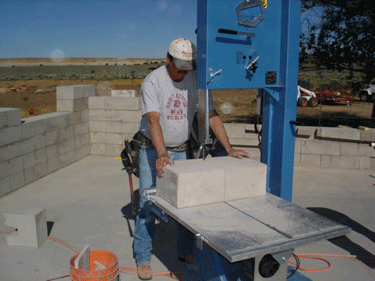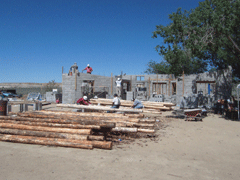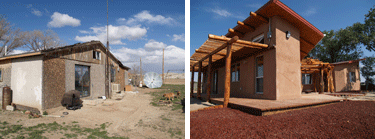From Ashes to Bricks
Air Date: Week of July 6, 2007

This home, built with flexcrete blocks, will be fireproof and wind-tested to 200 mph. (Photo: Gary Damron)
Even with the closure of the Mojave power plant, coal and coal waste are a major economic force in Navajo country. And as Daniel Kracker reports from Arizona, Navajos have found a new way to use coal plant waste from another power plant. They're making a new kind of concrete that could help solve the reservation's acute housing shortage.
Transcript
CURWOOD: It’s Living on Earth. I’m Steve Curwood. The place where the states of Arizona, Utah, Colorado and New Mexico meet is called the Four Corners region. And thousands of Navaho families live there in overcrowded, dilapidated buildings and trailers, often without running water or electricity. Many have waited for new homes — either from the federal or tribal government — for more than a decade. Now the tribe has a state-of-the-art facility that turns waste from burned coal into a new generation of building materials. As Daniel Kraker of Arizona Public Radio reports, the Navajo hope it will help solve their housing crisis.
[SOUND OF POWER PLANT]
KRAKER: Coal-fired power plants like the Navajo Generating Station just outside Page, Arizona, create 125 million tons of ash every year. A little more than half that is fly ash, the finest and lightest ash that would fly out the smokestack if it wasn’t captured. But at this enormous plant, environmental engineer Paul Ostapuk says a half million tons of fly ash are collected annually from the combustion airstream.
OSTAPUK: There’s 16 chambers, six electrical fields in each chamber. We charge the fly ash particles, they’re attracted then to electrical curtains, and we rap on those curtains and collect the fly ash down in hoppers.
[RAPPING SOUND]
OSTAPUK: So, that’s rapping.
[TRUCK SOUND]
KRAKER: Nationwide, about 60 percent of fly ash collected at power plants is landfilled or re-buried in the coal mines it came from.
[PASSING TRUCKS]

This home, built with flexcrete blocks, will be fireproof and wind-tested to 200 mph. (Photo: Gary Damron)
KRAKER: But that’s not the case at the Navajo Generating Station. Nearly all of the fly ash created here is trucked three miles down the highway to manufacture a unique new building material called flex-crete.
[PLANT SOUND]
KRAKER: Gary Damron manages the plant, which is owned by the Navajo Nation.
DAMRON: Right now, 40 percent of our mixture ratio is fly ash, so it’s a very large proportion.
KRAKER: The ingredients are mixed together and placed in a 20 foot long mold where millions of microscopic gas bubbles cause it to rise like a giant loaf of bread to about twice its height. It takes about two days for it to harden or cure.
[SAWING SOUND]
KRAKER: Then it’s sawed into bricks that look like traditional cinder blocks, but Damron says are more like an ideal combination between concrete and lumber. Though he says that makes some customers skeptical.
DAMRON: They’re like, ‘okay, we hear all the benefits.’ You know, it’s easy to work with, it’s a solid material, it has a very high R value as far as your heating and cooling requirements, it’s fire resistant, it creates a noise barrier. And they always say, ‘okay, tell me what’s wrong with it.’ Being that it’s a porous material, you do have to seal it. It’s susceptible to moisture if it’s left in a raw state; besides that, I don’t think there is a holdback to flex-crete.
KRAKER: Flex-crete is one of several building products known as aerated, or cellular, concrete that replace a portion of their cement with fly ash. The technology has existed for about 70 years in Europe, and more recently in this country. But Damron says flex-crete is the first concrete developed that doesn’t need to be autoclaved – essentially, cured in a giant pressure cooker.
DAMRON: To achieve the same thing we would achieve with flex-crete would cost this plant an additional 15 to 20 times more if we had to initiate an autoclave, and we would consume a large portion of energy to create the same thing.

(Courtesy of the ASU Stardust Center for Affordable Homes and the Family.)
KRAKER: Flex-crete, as well as other aerated concretes with names like e-crete and safe-crete, offer another environmental bonus. That’s because they use fly ash to replace cement. For every ton of cement produced, one ton of carbon dioxide is released into the atmosphere.
These new products, though, have been developed against the backdrop of a fierce disagreement over fly ash. The coal industry considers it a benign byproduct. Environmentalists, like Lisa Evans with the Clean Air Task Force, believe the ash, at least in its powdery form, is hazardous.
EVANS: Like the coal it came from, fly ash contains numerous heavy metals and other toxic substances, such as arsenic, chromium, lead, mercury, selenium, boron and more, and when the ash comes into contact with water, these hazardous substances leech out of the coal ash and enter the environment, sometimes in quantities, or often quantities, that are harmful to health and the environment.
KRAKER: But the EPA says fly ash is not a hazardous waste. As a result, it’s up to the states to regulate its disposal. The results have been uneven. A landfill leak in Indiana and a coal ash landslide in Pennsylvania have contaminated drinking water supplies. Evans says stricter disposal regulations would spur utilities to find more ways to reuse fly ash.
[SOUND OF PUMPING WATER AND PEOPLE TALKING ]
AUGUSTINE: It’s going to work for me…
[PUMPING]
KRAKER: In the northeast corner of the Navajo Nation, 73-year-old Mary Augustine tries out the water pump in front of her brand new home, the first on the reservation built with flex-crete. Mary and her husband Kee had been on a waiting list for a new home for years. Their old house had only one electrical outlet and a leaky roof. Now, Mary says, they’ll be able to stay here in this wide sandstone canyon dotted with cottonwoods.

The original Augustine residene that was demolished and replaced (left photo). Mary and Key Augustine's new home (right). (Photos courtesy of the ASU Stardust Center for Affordable Homes and the Family.)
KRAKER: That’s the TV show that rebuilds houses. This home, though, was built by the Navajo Housing Authority and designed by the Stardust Center for Affordable Housing at Arizona State University.
[DOOR OPENING]
KRAKER: Daniel Glenn, the center’s co-director, opens a door into the home’s entryway.
[DOOR CLOSES]
KRAKER: Inside it’s cool, despite the hot late summer sun. Glenn says he had planned to use straw bales, until he learned that flex-crete made a thicker 12 inch block.
GLENN: The disadvantage of straw bale is it’s not a good mass. It’s good insulator but not a good mass; in hot climates you need mass to absorb the heat. And so the 12-inch thick mass wall behaves extraordinarily well in this high desert climate.
KRAKER: That’s what the Navajo Housing Authority is banking on. The NHA financed the construction of the flex-crete plant in Page and has a 10 percent ownership stake in the technology. The Navajo Authority hopes its new, cheaper building product will help put a dent in the estimated 60,000 new homes needed across the reservation. For Living on Earth, I’m Daniel Kraker on the Navajo Nation.
Links
Living on Earth wants to hear from you!
Living on Earth
62 Calef Highway, Suite 212
Lee, NH 03861
Telephone: 617-287-4121
E-mail: comments@loe.org
Newsletter [Click here]
Donate to Living on Earth!
Living on Earth is an independent media program and relies entirely on contributions from listeners and institutions supporting public service. Please donate now to preserve an independent environmental voice.
NewsletterLiving on Earth offers a weekly delivery of the show's rundown to your mailbox. Sign up for our newsletter today!
 Sailors For The Sea: Be the change you want to sea.
Sailors For The Sea: Be the change you want to sea.
 The Grantham Foundation for the Protection of the Environment: Committed to protecting and improving the health of the global environment.
The Grantham Foundation for the Protection of the Environment: Committed to protecting and improving the health of the global environment.
 Contribute to Living on Earth and receive, as our gift to you, an archival print of one of Mark Seth Lender's extraordinary wildlife photographs. Follow the link to see Mark's current collection of photographs.
Contribute to Living on Earth and receive, as our gift to you, an archival print of one of Mark Seth Lender's extraordinary wildlife photographs. Follow the link to see Mark's current collection of photographs.
 Buy a signed copy of Mark Seth Lender's book Smeagull the Seagull & support Living on Earth
Buy a signed copy of Mark Seth Lender's book Smeagull the Seagull & support Living on Earth

